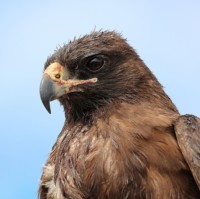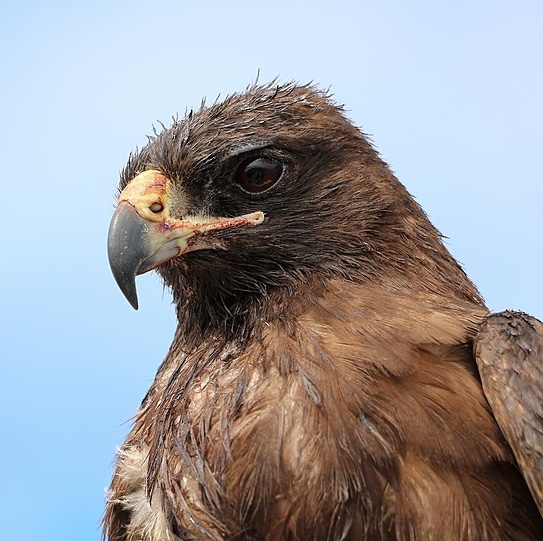
After the eradication of exotic goats on Santiago Island, Galapagos hawks prey deliveries consist mainly of introduced black rats
Linked Paper
The Diet of the Galapagos Hawk (Buteo galapagoensis) Before and After Goat Eradication. Jaramillo, M., Donaghy-Cannon, M., Vargas, F. H., & Parker, P. G. 2016. Journal of Raptor Research. DOI: 10.3356/rapt-50-01-33-44.1 View
Invasive species eradications are becoming increasingly common as a management strategy and are often effective in conserving local biodiversity and habitats around the world. However, not every program can predict the outcome of eradication on the complex interactions of plants and animals in a community. For this reason, available research should be carefully considered and long term monitoring of these communities should be planned and implemented effectively alongside eradication campaigns.
Under the constant watch of Galapagos hawks (Buteo galapagoensis), thousands of feral goats (Capra hircus) roamed the island of Santiago for centuries. Along with introduced pigs (Sus scrofa) and donkeys (Equus asinus), they outcompeted and predated on the island’s main herbivore, the famous Galapagos tortoise (Chelonoidis darwini), and likely contributed to the extinction of endemic land iguanas (Conolophus subcrustatus) (MacFarland et al. 1974). Grazing and stumping over grasses, shrubs and even trees, the ungulates exposed large areas of naked ground.
After the eradication of all invasive ungulates ended successfully in 2006 (Cruz et al. 2004, 2009 and Carrion et al. 2007), I began my M.S. work on the hawks of Santiago in 2008. I walked through thickets of vegetation in the transition zone, and sometimes in the arid zone: the unbreakable wartclub (Commicarpus tuberosis), the introduced Chinese Senna (Senna obtusifolia) that bounced back to hit me in the face, it’s pod often poking an eye, and the itchy and incredibly sticky native stickleaf (Mentzelia aspera) (or what I used to call the plant from hell), imagining our study area when goats were still there. I often thought about previous members of our research group, from the University of Missouri – St. Louis under Dr Patricia Parker, who had studied the hawks on this island since 1998, and I imagined them working in a very different place than the one I saw (Fig 1).

As I fell down on the ground, Segundo (a local assistant) used to tell me how they were able to run after the goats on those very same spots and how bare that same ground used to be. And I just couldn’t begin to grasp the degree of ecosystem change the top predator in that community was experiencing. How were they able to hunt, especially in the transition zone where you could see the vegetation recovery at its fullest (Fig 2)?

The local assistants, who were mostly ex-park rangers, would tell us stories about hawks, how tens and even hundreds of hawks would follow them around on the goat hunt when they were on Santiago. They would open the carcasses up after a kill and the hawks would take care of the rest, they said. Of course, it was mostly immature hawks, or what we call floaters, that followed them around. The floaters were not always there after the eradication and were never as abundant as before. The territorial Galapagos hawks were still there, but in smaller numbers and with reduced survivorship after the eradication of goats (Rivera-Parra et al. 2012); they watched me come in and out of their territories looking for active nests.
Territorial hawks have fairly stable polyandrous groups where one female can mate with up to eight unrelated males (Faaborg et al. 1995, Bollmer et al. 2003, Parker 2009) and they breed and forage within their territories, fiercely fighting off any invaders. Their diet includes terrestrial prey such as reptiles, in-vertebrates, rodents and goat carrion; and arboreal prey such as doves and passerine birds. As well as the occasional seabird or sea turtle neonate.
To determine changes in diet that could be related to the recovery of vegetation after goat eradication, we compared observations of prey deliveries before and after eradication. As movement of hawks between territories is restricted and hunting in the dense ground cover seemed very challenging, I thought that they would switch from a predominantly terrestrial prey diet to one with mainly arboreal prey. Furthermore, we expected shifts in diet to differ in the three main habitats in our study area according to the degree of change in vegetation cover. At the same time, we examined introduced rat captures within hawk territories to determine any changes in abundance that may be related to goat eradication and how this could possibly influence the territorial hawk’s breeding diet.
We did not observe the predicted switch in diet; quite the contrary, hawks delivered fewer arboreal prey items overall (Fig 3b). I still don’t know how they do it, as the hunting attempts that I witnessed in dense vegetation were always unsuccessful. However, after the eradication of goats, Galapagos hawks delivered mostly introduced rats to their nests, particularly in territories where the vegetation was denser (arid and transition habitats) (Fig 4). Before the eradication, introduced rats represented 20% of total prey biomass delivered compared to a surprising 73% after eradication.


As we predicted, the variation in hawk deliveries at nests was best explained by both habitat type and presence or absence of goats. Before eradication, deliveries of arboreal or terrestrial prey were pretty homogeneous between the three habitat types. However, after eradication, significantly more terrestrial prey and far fewer arboreal prey were delivered at arid and transition habitats than in lava habitat (Figure 3). This may indicate that terrestrial prey, or rats to be specific, may be more cost-effective than arboreal prey in dense vegetation, at least in terms of amount of food obtained per hunting effort.
Despite the nearly fourfold increase in rat biomass delivered at nests after eradication, rat captures were the same before and after eradication. And even though variation in rat captures was explained mostly by precipitation and years after eradication were wetter on average, than years before, the number of captures did not increase. To me this seems as an indication that hawk predation may be keeping the rat population in check. However, we have only scratched the surface of this rat-hawk interaction. Further studies would need to be done to determine to what degree predation by hawks may be affecting rat population growth and how that effect ripples down the food chain.
In any case, introduced rats have become a substantial element in the Galapagos hawks’ breeding diet post-eradication. Moreover, the decrease in consumption of arboreal prey in arid and transition habitats means that rats may be the main prey item in these areas during the breeding season. Thus, Santiago’s hawk breeding success may depend on rats being around to hunt. This could represent a serious threat for hawks now that an increasing trend of rat eradications around the world, including Galapagos, has gained momentum.
References
Bollmer, J.L., Sanchez,T., Donaghy Cannon,M., Sanchez, D., Cannon, B., Bednarz, J.C., de Vries, T., Struve, M.S. & Parker, P.G. 2003. Variation in morphology and mating system among island populations of Galápagos Hawks. Condor. 105: 428-438. View
Carrion, V., Donlan, C.J., Campbell, K., Lavoie, C. & Cruz, F. 2007. Feral donkey (Equus asinus) eradications in the Galapagos. Biodiversity and Conserva-tion. 16: 437–445. View
Cruz, F., Carrion, V., Campbell, K.J., Lavoie, C. & Donlan, C.J. 2009. Bio-economics of large-scale eradication of feral goats from Santiago Island, Galápagos. Journal of Wildlife Management. 73: 191-200. View
Cruz, F., Donlan, C. J., Campbell, K. &Carrion, V. 2004. Conservation action in the Galapagos: feral pig (Sus scrofa) eradication from Santiago Island. Biological Conservation. 121: 473–478. View
Faaborg, J., Parker, P.G., DeLay, L., de Vries,Tj., Bednarz, J.C., Paz, S.M., Naranjo, J. & Waite, T.A.1995. Confirmation of cooperative polyandry in the Galapagos hawk (Buteo galapagoensis) using DNA fingerprinting. Behavioral Ecology and Sociobiology. 36: 83-90. View
Macfarland, C.G., Villa, J. & Toro, B. 1974. The Galapagos giant tortoises (Geochelone elephantopus), part I: status of the surviving populations. Biological Conservation. 6: 118–133. View
Parker, P.G. 2009. A most unusual hawk: One mother and several fathers. In: De Roy T. (ed) Galapagos: preserving Darwin’s legacy. pp.130-137. Firefly Books: Ontario, U.S.A.
Rivera-Parra, J.L., Levenstein, K.M., Berdnarz, J.C., Vargas, F.H., Carrion, V. & Parker, P.G. 2012. Implications of goat eradication on the survivorship of the Galapagos hawk. Journal of Wildlife Management. 76: 1197–1204. doi: 10.1002/jwmg.372 View
Image credit
Featured image: Galapagos hawk (Buteo galapagoensis) Bernard Gagnon CC-BY-SA-4.0 Wikimedia-Commons
If you want to write about your research in #theBOUblog, then please see here.




